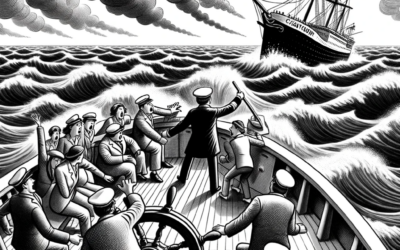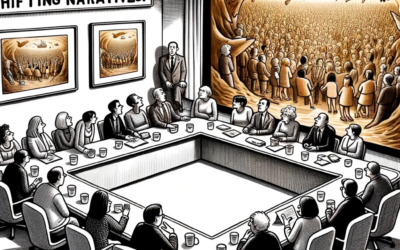Why Leaders Keep Solving the Wrong Problems
Many smart leaders fall into the same trap: solving problems quickly without questioning the assumptions behind them. This is what Harvard psychologist Chris Argyris called “single-loop learning.” But the leaders who thrive long-term practice something different: double-loop learning in leadership. Instead of just fixing issues, they reframe them—challenging goals, beliefs, and systems to ensure they’re solving the right problems. In this post, we’ll explore why so many leaders keep solving the wrong problems and how double-loop learning can fix it. If you have a HBR subscription, I’ll link the paid article here. The previous links provide free sources.
What Is Single-Loop Learning in Leadership?
Argyris used a thermostat metaphor that still works today:
- Single-loop learning is like a thermostat set to 72°F. If the room gets too cold, the heat kicks on. If it’s too hot, it turns off. The goal? Maintain the set temperature. Efficient, yes. But rigid.
- The thermostat never asks, Why 72°F?
- It never considers whether maybe—just maybe—72 isn’t what we actually need.
In organizations, single-loop learning is problem-solving inside the frame of current assumptions. We fix errors without questioning the rules of the game.
It’s not bad—it’s essential for day-to-day functioning. But it’s also the reason so many teams spin in circles. You can be incredibly good at solving the wrong problem.
What Is Double-Loop Learning in Leadership?
Double-loop learning is when you zoom out and say:
“Wait—are we even aiming for the right temperature?”
It’s about questioning the assumptions, norms, and values that set the goals in the first place.
Instead of just asking, How do we fix this?, you also ask, Why do we think this needs fixing in this way?
That second question is where the magic happens. It shifts you from reacting to reframing.
Why Leaders Resist Double-Loop Learning
Here’s the rub: double-loop learning is uncomfortable. It often means confronting these truths:
- We might be wrong.
- Our beliefs might be outdated.
- Our sacred cows might need… well, you know.
In corporate life, people are rewarded for speed, decisiveness, and confidence—not for sitting in the awkward pause of “Hmm, maybe we’ve been looking at this backwards.”
Argyris found that smart, successful people are often the worst at double-loop learning because their success reinforces their existing mental models. If something’s worked for you before, why wouldn’t you trust it again?
How Double-Loop Learning Works in Practice
Let’s break it down like a coach watching game tape:
- Trigger – Something happens that doesn’t match expectations (a failed project, unexpected customer behavior, a strategy flop).
- Reaction (Single Loop) – “Okay, what can we tweak to get back on track?”
- Reflection (Double Loop) – “Why did we think this was the track in the first place? What assumptions drove that?”
- Reframing – You adjust not just the tactics but the belief system or mental model guiding those tactics.
Think of it like this: Single loop is fixing the map. Double loop is asking if you’re even in the right country.
Learning Example: How Netflix Transformed Its Business
Remember when Netflix started out mailing DVDs?
- Single-loop world: Improve shipping logistics, negotiate better USPS rates, make the red envelopes shinier.
- Double-loop world: Ask, “Do people actually want DVDs—or do they just want the movies?”
That question led to streaming. And then to content creation. And now Netflix isn’t a DVD company at all.
Single-loop tweaks might have kept them afloat for a few more years. Double-loop thinking turned them into a category-defining powerhouse.
Why This Matters in a Coaching Context
When I’m coaching leaders, double-loop learning is where transformation happens.
It’s where:
- Leaders stop firefighting and start redesigning the fire code.
- Teams move from compliance to commitment because they understand the why behind the work.
- Cultures evolve to prize learning over being right.
I’ve seen executives go from “We need to motivate our sales team” to “We’ve been rewarding individual wins in a market that actually demands cross-functional collaboration.” That’s a shift in the system, not just the symptoms.
The Hidden Enemies of Double-Loop Learning in Leadership
You don’t just decide to “do” double-loop learning. You have to fight these three sneaky enemies:
- Defensive Routines – We protect our self-image at all costs. Argyris found that high achievers often deflect blame faster than you can say “market conditions.”
- Organizational Silence – People know the sacred cows but never speak them aloud. It’s the “we don’t go there” list.
- Action Bias – Leaders love doing something now—even if it’s the wrong something—because it feels productive.
The result? Teams keep optimizing the wrong thing.
How to Build a Double-Loop Culture
Here’s the part where we get practical—Ann Handley style.
1. Make It Safe to Question the Rules
If asking “Why do we do it this way?” gets you labeled as negative or difficult, double-loop learning dies before it starts. Leaders have to normalize curiosity—even when it’s inconvenient.
2. Separate the Self from the Solution
Critiquing an idea isn’t the same as critiquing the person. This sounds simple, but it’s the linchpin for keeping people in the conversation instead of shutting down.
3. Embed Reflection into the Workflow
Don’t relegate reflection to offsites or crises. Build it into your debriefs: “What did we learn?” should always include “What assumptions did we challenge?”
4. Reward Insight, Not Just Outcomes
If you only celebrate the win, people will hide the process it took to get there—especially the wrong turns. Reward the insight that changes the game.
The Loop in Action: Leadership Conversations
Leader: “Our new product launch flopped. We need a stronger ad campaign.”
Coach: “Maybe. But what made us believe this product would resonate in the first place?”
Leader: “…Because our past customers loved similar features.”
Coach: “And what’s changed about our customers since then?”
Leader: “…They’re younger now, more price-sensitive, and more eco-conscious.”
Coach: “So the problem might not be the ads—it might be the product-market fit.”
That’s double-loop learning in real time: shifting the conversation from tactics to underlying premises.
The Benefits of Double-Loop Learning for Leaders
Double-loop learning isn’t about being philosophical for philosophy’s sake. It’s about:
- Better decisions – Because they’re grounded in reality, not nostalgia.
- Faster adaptation – Once questioning becomes a habit, you spot changes sooner.
- Resilient teams – People who aren’t afraid to surface the uncomfortable truth.
Argyris put it bluntly: Organizations that can’t double-loop become brittle. They don’t just risk making bad decisions—they risk becoming irrelevant.
Closing the Loop (Pun Intended)
Double-loop learning asks you to live in the tension between knowing and wondering. Between action and reflection.
It’s a muscle you build—not a switch you flip. And like any good workout, it’s uncomfortable at first. But over time, you get stronger. More flexible. More able to adapt to whatever’s next.
And if you’re a leader—or a coach—it might be the single most important skill you develop. Because in a world that’s moving faster than ever, the winners won’t just be the ones who solve problems. They’ll be the ones who redefine them.



